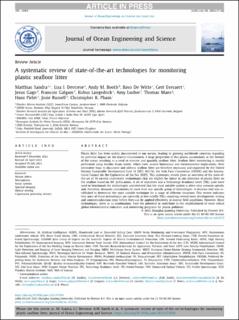| dc.contributor.author | Sandra, Matthias | |
| dc.contributor.author | Devriese, Lisa I. | |
| dc.contributor.author | Booth, Andy M. | |
| dc.contributor.author | De Witte, Bavo P. | |
| dc.contributor.author | Everaert, Gert | |
| dc.contributor.author | Gago, Jesus | |
| dc.contributor.author | Galgani, Francois | |
| dc.contributor.author | Langedock, Kobus | |
| dc.contributor.author | Lusher, Amy | |
| dc.contributor.author | Maes, Thomas | |
| dc.contributor.author | Pirlet, Hans | |
| dc.contributor.author | Russell, Josie | |
| dc.contributor.author | Pham, Christopher K. | |
| dc.date.accessioned | 2023-09-28T11:45:09Z | |
| dc.date.available | 2023-09-28T11:45:09Z | |
| dc.date.created | 2023-08-09T12:59:46Z | |
| dc.date.issued | 2023 | |
| dc.identifier.citation | Journal of Ocean Engineering and Science. 2023, . | en_US |
| dc.identifier.issn | 2468-0133 | |
| dc.identifier.uri | https://hdl.handle.net/11250/3092722 | |
| dc.description.abstract | Plastic litter has been widely documented in our oceans, leading to growing worldwide concerns regarding its potential impact on the marine environment. A large proportion of this plastic accumulates at the bottom of the ocean, resulting in a need to monitor and quantify seafloor litter. Seafloor litter monitoring is mostly performed using benthic beam trawls, which have several limitations and environmental implications. New innovative ways to document and address seafloor litter are therefore necessary and requested by the United Nations Sustainable Development Goal 14 (SDG 14.1.1b), the Oslo Paris Convention (OSPAR) and the International Council for the Exploration of the Sea (ICES). This systematic review gives an overview of the state-of-the-art of 14 current underwater technologies that are eligible for future in situ detection of plastic litter on the seafloor based on 101 publications. A set of objectives and a Technology Readiness Level (TRL) scale were used to benchmark the technologies and revealed that the most suitable system is often very scenario-specific and, therefore, demands investments in more than one specific group of technologies. A decision tool was established to determine the most suitable technique for a range of different situations. This review indicates that most of these technologies are currently at low-middle TRLs, requiring several more development, testing and commercialization steps before they can be applied effectively in marine field conditions. However, these technologies, alone or in combination, have the potential to contribute to the establishment of more robust global environmental indicators and monitoring programs for plastic pollution. | en_US |
| dc.language.iso | eng | en_US |
| dc.publisher | Shanghai Jiaotong University | en_US |
| dc.rights | Attribution-NonCommercial-NoDerivatives 4.0 Internasjonal | * |
| dc.rights.uri | http://creativecommons.org/licenses/by-nc-nd/4.0/deed.no | * |
| dc.subject | Marine debris | en_US |
| dc.subject | Macroplastic | en_US |
| dc.subject | Sonar systems | en_US |
| dc.subject | Spectral imaging | en_US |
| dc.subject | Optical sensing | en_US |
| dc.subject | Capacitance proximity sensors | en_US |
| dc.title | A systematic review of state-of-the-art technologies for monitoring plastic seafloor litter | en_US |
| dc.title.alternative | A systematic review of state-of-the-art technologies for monitoring plastic seafloor litter | en_US |
| dc.type | Journal article | en_US |
| dc.type | Peer reviewed | en_US |
| dc.description.version | publishedVersion | en_US |
| dc.rights.holder | ©2023 Shanghai Jiaotong University. Published by Elsevier B.V. This is an open access article under the CC BY-NC-ND license (http://creativecommons.org/licenses/by-nc-nd/4.0/) | en_US |
| dc.source.pagenumber | 18 | en_US |
| dc.source.journal | Journal of Ocean Engineering and Science | en_US |
| dc.identifier.doi | 10.1016/j.joes.2023.07.004 | |
| dc.identifier.cristin | 2165899 | |
| cristin.ispublished | false | |
| cristin.fulltext | original | |
| cristin.qualitycode | 1 | |

